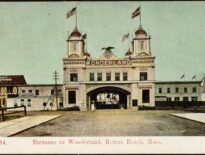
Gov. Charlie Baker wants the legislature to support a new type of zoning district geared towards homes no bigger than 1,850 square feet on quarter-acre lots or smaller.
The modest capes and ranches that marked the post-war building boom have long since given away to McMansions with seven-figure price tags in Boston’s suburbs.
So, can the inexpensive starter home, once the ticket to the middle class, make a comeback here in Massachusetts, the land of crazy real estate prices?
As he wraps up his final months in office, Gov. Charlie Baker appears determined to give it another try, launching what is effectively his second bid to resurrect the extinct species of the residential real estate market.
The governor’s proposal, which would spur construction of a 21st century version of these classic starter homes, got a public airing last week on Beacon Hill.
The state legislature’s Joint Committee on Economic Development and Emerging Technologies heard testimony on behalf of the starter home district proposal as well as other parts of the governor’s $3.5 billion economic development package.
The proposal is significantly revamped from an earlier initiative the Baker administration rolled out in 2016. That effort fell flat, with no suburbs taking part, a story I broke in a piece for CommonWealth Magazine and wrote about in his space as well.
The core of the proposal is the same: Towns and cities across the state would be able to create special districts which would have, at a minimum, four homes per acre, with each home capped at 1,850 square feet.
But the new and revamped version of Baker’s starter home initiative removes what critics say was effectively a poison pill embedded in the program, a rather mystifying requirement that starter homes be built near T stations.
No More Poison Pill
For obvious reasons, not least of which most commuter rail stations are often in densely built-out downtowns, that simply didn’t work.
No one is going to build a subdivision, even one with four or five homes to an acre, next door to a train station or subway stop.
Simple economics argued against it: Land in downtowns near T stations is more expensive to buy than ever before, all but requiring a large multifamily project with lots of condominiums and apartments in order to make a profit.
Baker’s new proposal gives communities the latitude to place the starter districts in parts of town better suited to suburban-style homes.
Why it took so long to make the shift – and remove this illogical restriction – is another question. State housing officials, questioned on the issue, were oddly defensive and reluctant to admit the obvious.
Now the question is whether the proposal can make it through the legislature, never a sure bet.
Concept Gets Big Backing
At the moment, the fate of Baker’s starter home bill is tied to his popular multibillion-dollar economic development proposal.
A trio of industry groups are also going to bat for the governor’s plan.
First, the Greater Boston Real Estate Board and the Massachusetts Association of Realtors have issued a joint letter endorsing the proposal.
“Smaller homes on smaller lots are ideal for seniors who want to downsize but stay in their towns, families looking to buy their first home, or anyone who does not want or cannot afford to buy a house at current prices, especially in many Massachusetts towns where median home values soar into the millions,” the groups noted in the testimony at last week’s State House hearing.
The two groups join the Home Builders and Remodelers Association of Massachusetts, which has long championed the starter home proposal, arguing it is needed in lopsided

Scott Van Voorhis
market where the only new homes getting built are larger, luxury homes.
Prominent members of the homebuilders’ group were also vocal in their insistence that the initiative would not have a fair chance of succeeding as long as the T station requirement was in effect.
As a result, Baker’s new proposal gives communities the latitude to place the starter districts in parts of town better suited for suburban-style, single-family housing and where typically luxury homes on 1 or 2 acres would otherwise be built.
“The administration recognized the inherent contradiction,” said Benjamin Fierro III, general counsel for the homebuilders’ association. “It was a round peg in a square hole.”




 |
| 

